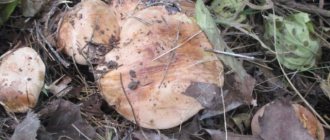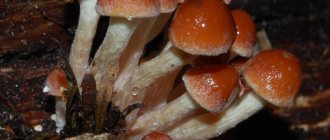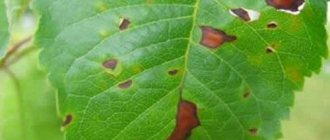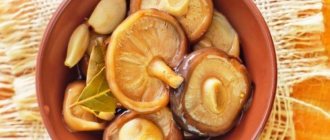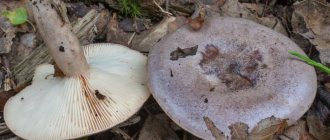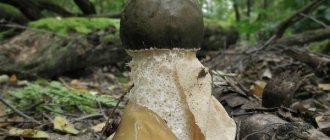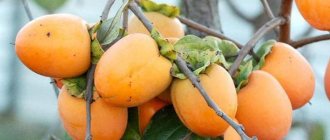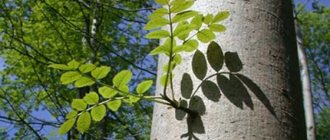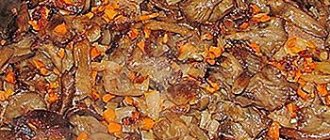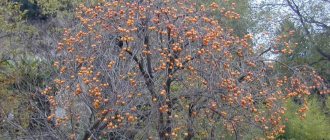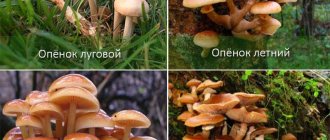Autumn honey fungus, also known as real honey fungus
If in the fall you happen to see a basket of freshly picked honey mushrooms at the market or at a mushroom picker you know, then most likely this is the autumn honey fungus (see photo at the beginning of the article). This mushroom is very widespread throughout the temperate zone of our continent (by the way - in North America too), and in certain years - when there is a wet and more or less warm autumn - it bears fruit so en masse that half a ton of it is collected from one hectare.
Autumn honey fungus is found in any forest - both coniferous and deciduous. It is extremely indiscriminate in its choice of host and can parasitize on a fair number of plants, including all the trees known to us, as well as a wide variety of shrubs and herbs. Under favorable conditions, it is capable of temporarily “retraining” from a parasite into a saprophyte and feeding on dead plant debris.
The autumn honey fungus is very recognizable, therefore it is recognized quite quickly even by novice mushroom pickers. Its fruit bodies usually have a pleasant-looking yellowish color - the color of honey (for which it is called “honey mushroom” in Latin), or not very intensely orange, or light brown. Some experts associate the shade with the wood on which the honey fungus grows.
Still young, but edible honey mushrooms grow in dense clusters, have small - 3-5 cm in diameter, convex caps with slightly turned up edges on thin but strong legs - up to 10 cm long, often merging at the base. Both the caps and legs are usually covered with dark scales, which disappear with age (in the center of the cap these scales form a kind of dark spot). An obligatory attribute (one of the signs by which autumn honey fungus can be distinguished from poisonous false honey mushrooms) is a ring on a stalk almost at the very base of the cap, left over from the bedspread. And the younger the mushroom, the more likely it is that it will be a membrane - full or partial, covering the plates on the inside of the cap.
Photo 2. Young fruiting bodies of honey fungus on the roots of an old tree. Author: Andreas Eichler
With age, the cap of the honey fungus unfolds, expands and flattens. Its flesh becomes coarse, making it virtually unfit for food. Perhaps such mushrooms can be used for decoction (and then thrown away), or they can be fried, stewed and finely rolled into caviar. But, as practice has shown, with age the honey fungus not only becomes stiff, but also somewhat loses its taste, which is why more or less picky mushroom pickers categorically neglect it.
Photo 3. A decent “plantation” of ripened fruiting bodies of the autumn honey fungus on old, almost rotten woody remains. Author: Harlock81.
Autumn honey fungus begins to bear fruit in August - towards the end of the month; it appears most en masse in our forests in September , despite all this - it continues to release fruiting bodies until October - until the very beginning of the real winter (in other years, when the autumn is warm - it can be collected until December ).
Seasoned mushroom pickers claim that honey mushrooms come in “three layers,” and you can also hear a story from them that mushrooms can appear in July, but such a statement is due to ignorance of scientific subtleties. For at the height of summer, slightly different types of honey mushrooms appear.
Giant honey fungus growing in the Malure Nature Reserve in the US state of Oregon
US scientists have discovered a giant honey mushroom, the largest living organism on earth, in the Malheur Nature Reserve in Oregon. He is rightfully considered the largest living creature on the planet, because. the mycelium occupies an area of more than 880 hectares, and the age determined by mycologists is more than 2.4 thousand years.
Sometimes it is even called the Oregon monster, because its mycelium, feeding on trees, envelops their roots, spreads under the bark and as a result the plants die. Biologists first noticed the mass death of trees in 1998, which led to a study of the causes. It turned out that the mushrooms growing throughout the entire area are not individual specimens, but a single giant organism.
Dark honey mushrooms are tasty and healthy forest gifts that are easy to distinguish from their counterparts and are easy to prepare. You should carefully collect the forest harvest so that poisonous specimens do not end up in the basket; for this, you should not collect unfamiliar fruits. Spruce mushrooms are easy to distinguish from their counterparts, their taste is highly rated, and their popularity has not fallen for many years.
Northern honey fungus
He is also the northern autumn honey fungus. In many ways it is similar to the previous mushroom, except that it differs in color - it is more often light brown than yellow, at least in our area. It also sometimes looks a little stronger.
Photo 5. Mature fruiting bodies of the northern honey fungus. Author: Kärt Urman.
In terms of other characteristics - from the preferred forests to the timing of fruiting - this mushroom fully corresponds to the autumn honey fungus.
Autumn thick-legged honey fungus
It differs from the usual autumn honey fungus in having a thicker leg at the base, its color is almost identical, but at times it is somewhat lighter and paler, and sometimes with light scales instead of dark ones. In addition, this mushroom looks stronger and does not grow in large clusters, but throws out fruiting bodies in groups of no more than a dozen. Not seen on living trees; it feeds on rotting plant debris, so it can more often be found on windbreaks and forest floors.
Fruits from August to October - evenly, without “layers”. In particularly warm years, fruiting bodies may appear as early as July. It is edible and is not inferior in taste to ordinary autumn honey fungus.
Autumn bulbous honey fungus
It is very similar to the previous mushroom (as well as to other autumn mushrooms), especially with a stalk, which has a characteristic tuberous swelling at the very base - but usually those mushrooms that grow on trees, those that appear on the ground, have a “standard” stalk ", thin. However, the cap of the bulbous honey fungus is usually noticeably darker than the stem, and the color of the entire fruiting body is often quite bright, varying from brown to outright yellow tones.
The bulbous honey fungus bears fruit from August to September (the peak of fruiting occurs in the second month), usually appears in deciduous forests in a friendly layer on dead wood, old stumps and rotted wood debris.
Photo 8. Young fruiting bodies of the bulbous honey fungus on mossy dead wood. Author: Tony Hisgett.
In terms of edibility, it is somewhat inferior to real honey fungus (this is especially true for frail fruiting bodies growing on the soil). Mushroom pickers who know a lot about honey mushrooms note that it is better to throw away the very bottom part of the stem - it is, as a rule, especially hard and has completely unsightly nutritional qualities.
Location on
If cultivation is planned on the ground, select an area under deciduous trees, remove the top layer of soil, then pour the prepared mixture (infused water with crushed caps) evenly around the entire perimeter, or lay pieces of mycelium, cover with a layer of removed soil and water.
Further care of the plantings consists of regular but moderate irrigation and shelter from the scorching sun during the midday hours.
To protect against pests that would not mind eating - snails, slugs, the area around the mycelium can be thoroughly sprinkled with ash. To prevent fruiting bodies from being damaged by worms, you should harvest on time.
Honey fungus shrinking
He is also an oak honey fungus, a ringless honey fungus. Another species from the genus of true honey mushrooms, preferring broad-leaved species to other trees. It is most often collected from oak trees, which is why it received one of its alternative names. It is also not called ringless for nothing - the fruiting bodies of the honey mushroom do not have a drying cover, so its stem is always without a ring, which greatly increases the chances of confusing this mushroom with false honey mushrooms, so only experienced mushroom pickers collect it.
Photo 0. Fruiting bodies of the shriveling honey fungus close-up. Author: Katja Schulz.
However, the typical “honeycomb” hairiness of the fruiting body and the presence of scales on the cap are eloquent signs that make it clear that we are dealing with a representative of true honey mushrooms.
This mushroom bears fruit from July to October . In warm summers, fruiting bodies may appear earlier - as early as June.
In terms of taste, the shrinking honey mushroom corresponds to other real honey mushrooms.
Summer honey fungus
This mushroom, despite its considerable similarity, has nothing to do with real honey mushrooms. This is a representative of fungi with the unpronounceable name “Kyneromyces”. However, it is quite edible and is collected just as actively.
It grows on damaged living trees, but prefers rotten wood, and not just any wood, but deciduous wood (although sometimes this fungus is also observed on coniferous trees).
Photo 10. The lower surface of the cap of the summer honey fungus. Author: Björn S…
Summer honey fungus bears fruit virtually throughout the warm season - from April to November (and in countries with a mild climate - all year round).
The size of the fruiting bodies of the summer honey fungus is slightly different than that of the autumn one - the cap does not grow more than 6 cm in diameter, the leg is also three centimeters shorter. The color is somewhat lighter, more yellowish. The main difference is a wide tubercle on the cap, very noticeable - usually light, but sometimes dark. In addition, the caps of summer honey mushrooms are often smooth, and if they have scales, they are light.
This mushroom has a poisonous “double” (which will be discussed below in the chapter on the distinctive features of edible mushrooms from false and poisonous ones), so only experienced mushroom pickers collect it.
Growing in a log
This type of mushroom is unpretentious - they can be successfully grown artificially at home. Apartment, basement or greenhouse conditions are suitable for this.
The main thing is to provide the mycelium with good lighting, a temperature of 10 to 15 ° C and constant humidity at 70-80%. Good ventilation is also important, and when growing in winter, high-quality heating to maintain the required level of heat. When grown in summer, refrigeration will be required.
You can grow mushrooms in the wood of deciduous trees. As a material, you can use fragments of forest mycelium that appeared in the bark. Before laying it is divided into small pieces.
The caps of old fruiting bodies are also suitable. They are soaked in water for a day, then kneaded and poured along with the pulp onto the prepared surface.
When growing in a log of dead or only cut wood, it is necessary to make several depressions in it to lay the mycelium. You can place the log in a basement or cellar, the main thing is to ensure the above-described conditions for growth and development.
Winter honey fungus
This mushroom - despite the name, as well as some external resemblance to true honey mushrooms and the “habit” of growing on stumps and trees - is by no means a honey mushroom. To be honest, this is the most natural row.
Photo 12. Winter honey mushrooms - the lower surface of the caps. Author: Eric Steinert.
But it is called “winter” for a reason - it is one of the few mushrooms of our latitudes that can develop at very low temperatures, close to zero.
The fruiting season for winter honey fungus is from late autumn to early spring .
It’s clear that in 40-degree frosts you won’t get a harvest from it - at this moment it will be in a state of suspended animation. But as soon as the thaw sets in, the mushroom instantly comes to life and throws out fruiting bodies, which can be seen even in the city - peeking out from under the snow - on ancient, well-worn poplars, or stumps - left over from them.
In addition to poplars, this fungus “occupies” willows, less often other deciduous trees, mainly old or damaged ones, as well as everything that remains from their felling or windfall. It grows everywhere, from forests to parks and gardens, but it is especially abundant along the banks of small rivers and streams.
In warm winters, I often observe winter mushrooms in the yard of my house - on old poplars. Mushrooms look very unusual, dusted with snow.
Winter honey fungus is edible and has a very good taste, for which it is cultivated in Japan and Korea, and recently in some other countries. It is known throughout the world under the trade name “enokitake”; the youngest fruiting bodies, grown in the dark and devoid of pigment, similar to bunches of light “pins”, are sold.
Photo 14. Winter honey mushrooms grown on an artificial substrate - “enokitake”. Author: Wendell Smith.
However, in our country it is not collected by all mushroom pickers: winter honey fungus is very similar to false honey mushrooms - it does not have a ring on the stem, and its color is just as bright. In addition, there is information that this mushroom may contain a small amount of toxins that cause digestive upset (for which it is always recommended to boil it first).
The cap is from 2 to 10 cm in diameter, convex in young fruiting bodies, flat in old ones, usually has a yellowish or orange-brown color, richer in the center, paler at the edges. The leg is up to 7 cm long, up to 1 cm in diameter, hollow inside, velvety, brownish-yellowish, lighter in the upper part.
Experienced mushroom pickers recognize and distinguish it without difficulty. The main feature is the time of growth. In winter, by definition, no false honey mushrooms can bear fruit, especially on trees, and winter honey mushrooms sometimes “climb” very high.
Honey fungus
Another fake honey fungus, which is directly related to non-rotting mushrooms. It is named honey mushroom only for its partial external resemblance to true honey mushrooms, but otherwise it is not at all similar to them.
Fresh fruiting bodies of the meadow honey fungus are usually small: the cap is on average 5 cm in diameter, the stem is 6 cm long, occasionally there are specimens with an 8-centimeter cap and a stem up to 10 cm. The color is ocher-brownish, depending on the weather: in the heat it is paler than at high humidity (in this case the cap also becomes sticky). The mushroom does not have a ring on the stem - which is why it is similar in appearance to some “toadstools”, so only experienced mushroom pickers collect it. However, in some places the meadow honey fungus is quite popular.
This mushroom avoids forests, preferring open spaces overgrown with grass, especially those where cows and other herbivores often graze, and the ground is well fertilized. The honey fungus is a typical saprophyte that feeds on organic debris.
It bears fruit almost throughout the warm season - from the end of May to the end of October .
"Royal honey fungus" (hairy scale)
This example of the mushroom kingdom also has nothing to do with honey mushrooms. Nevertheless, among the people the nickname “royal honey fungus” has stuck to it, so I will still mention it.
It was called “royal” primarily for its appearance - the mushroom looks very impressive and photogenic, has a beautiful bell-shaped cap and is completely covered with large scales, the pattern of which vaguely resembles a royal robe.
As for the taste, the opinions of mushroom pickers are divided. Some consider this mushroom to be tasteless, while others, on the contrary, praise it and value it higher than the usual autumn mushroom. The fleecy scale has a distinct “rare” taste and smell.
“Royal honey fungus” grows in any forest - on stumps and trunks of old trees on rotting wood. Fruits from mid-August to late autumn .
Harm and contraindications
Like any representative of the mushroom kingdom, spruce mushrooms have their own characteristics of use.
- Due to the chitin contained in the mushroom, they are contraindicated for children under 3 years of age. Mushrooms will be very difficult to digest, which is unpleasant for the child’s body.
- Pregnant and breastfeeding women should also avoid eating mushrooms.
- If you have problems with the gastrointestinal tract, then the consumption of spruce mushrooms should be limited to 1-2 times a week. In more serious cases, it is better to abandon them altogether.
About the places where honey mushrooms grow
It would seem that it is easier to find honey mushrooms than steamed turnips: purely logically, they should be in any forest in which their potential host plants grow. But in reality, everything turns out to be more complicated: we are surrounded by giant forests, but no matter where honey mushrooms are found in them, but only in special places - which are “registered” with seasoned mushroom pickers and are strictly classified.
Why is that? The thing is that trees and shrubs have existed side by side with parasitic fungi for millions of years, and over this very considerable period they have “learned” to defend themselves quite successfully from them.
The first bastion of this defense is the bark, which is essentially an armor through which no spores can grow. If the tree bark is intact, then it is not afraid of parasitic mushrooms.
If suddenly the bark is damaged, then a second means of defense comes into play - chemical substances that suppress the development of fungi (garden fungicides are a kind of analogue of these substances). Any plant secretes especially a lot of these substances at a young age - when it develops intensively.
Therefore, in places where the trees are young and healthy, honey mushrooms are unlikely to bear fruit, it most likely makes no sense to look for these mushrooms there.
But where the trees are old or damaged, where there are stumps, fallen trunks or dead wood, honey mushrooms, as a rule, develop “with a bang” and throw out their fruiting bodies quite quickly. If you want to find them, go to some old forest, for example, with huge birch trees, whose trunks are 80 centimeters in diameter. And pay attention to the butt and roots of these very trunks - if they are quite overgrown with moss and lichen, it means that all the necessary conditions for mushrooms have been met. Here honey mushrooms grow not only on the bark of old trees (sometimes “climbing” very high), but also on their roots, so they can often be seen not on the trunk, but right on the ground.
The next places where you can successfully collect honey mushrooms are clearings, and it doesn’t matter at all whether they are fresh or old. Although it has been noted that in ancient clearings honey mushrooms grow more intensively, the fact that the first fruiting bodies appear on stumps a little more than six months after logging is known for certain.
In places where the felling of trees occurred for natural reasons - from the wind, for example, honey mushrooms also appear quite quickly. Therefore, any areas of the forest littered with windfall also need to be inspected during collection.
From my own experience, I can also add the following: honey mushrooms (at least ours - the Ural ones) do not particularly like places well warmed by the sun. They definitely prefer shade and some coolness, so you should look for them on the northern slopes of the mountains, in logs or ravines, as well as in spruce forests mixed with other trees.
In such places, I often observed breathtaking accumulations of mushrooms that covered everything with an orange carpet - stumps, the base of trees, fallen trunks, and the forest floor. From one average stump it was possible to easily cut a whole basket of honey mushrooms.
The main thing is to be in such a place on time - when the fruiting bodies are still small, tender, and have not developed into “burdocks”, at the same time becoming tough and inedible.
Areas of use
Flammulina is widely used in cooking: in second courses, salads, sauces, pickles and marinades. But before using the found mushrooms for food, it is necessary to take into account that they must undergo high-quality heat treatment . The fact is that they are included in the fourth category of edible mushrooms (conditionally edible) due to the fact that they contain a weak, unstable toxin. During heat treatment, in particular during cooking for at least 20 minutes, the poison is destroyed and the mushroom becomes completely suitable for consumption.
Someone might wonder, why even bother with such a dubious mushroom if there are a huge number of equally tasty, but much easier to process? There are several answers to this question:
- Useful properties of flammulina. Japanese scientists in the middle of the last century discovered an amazing quality of the winter mushroom: it contains a substance called flammulin, which prevents the occurrence of cancer and helps fight existing ones. Further research only expanded the list of valuable properties of winter honey fungus. As it turned out, it has a beneficial effect on the stomach and liver, helping to prevent diseases and stimulate the immune system.
- The time of year in which flammulina is harvested. It must be admitted that in winter it is difficult to treat yourself to fresh mushrooms: you can only buy them in the store. And personally collected winter mushrooms, which also have a festive bright color, turn out to be a very pleasant addition to the standard diet. In addition, the fact that flammulins are most active in winter helps to avoid encounters with dangerous doubles characteristic of other types of honey mushrooms.
